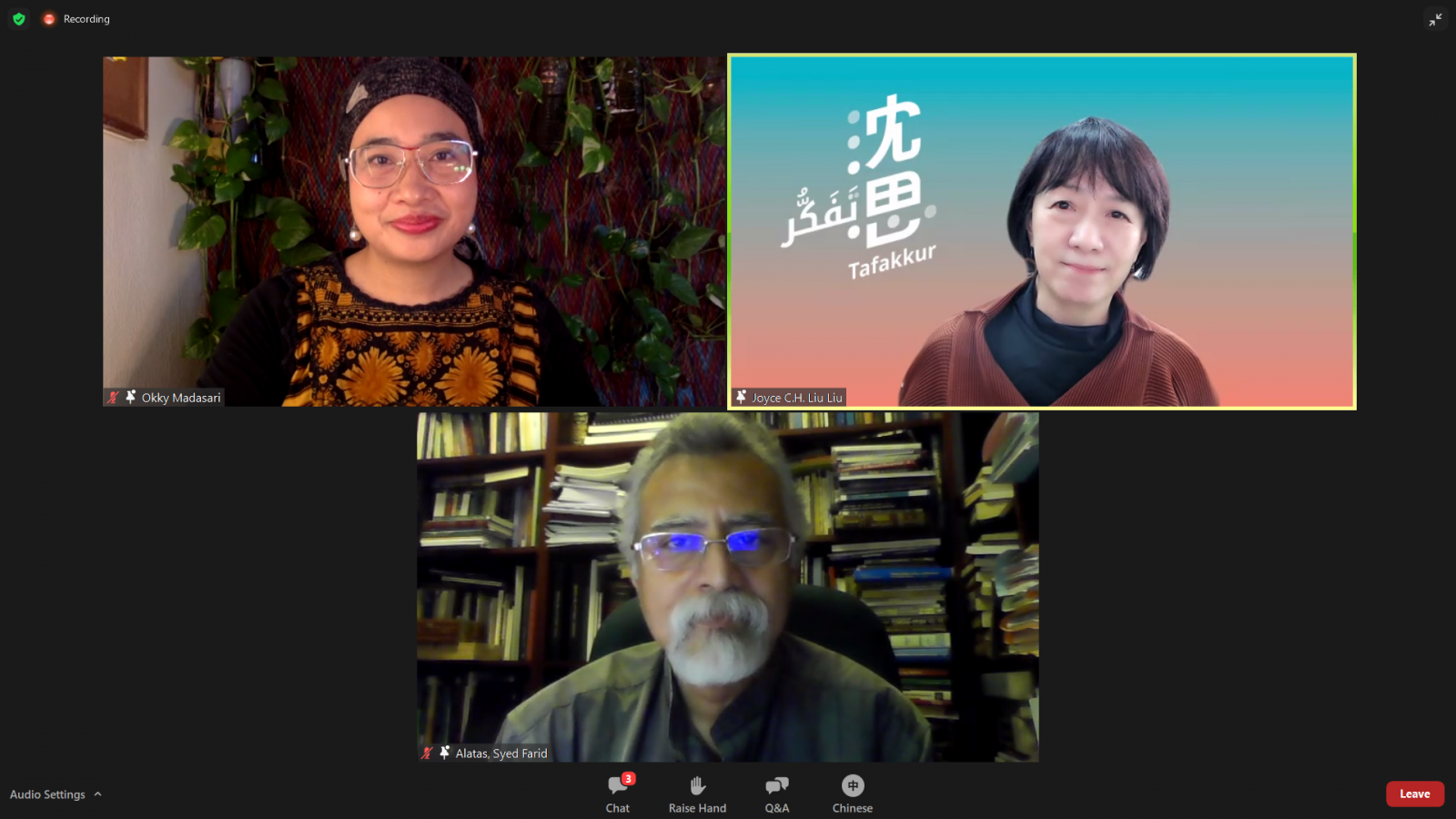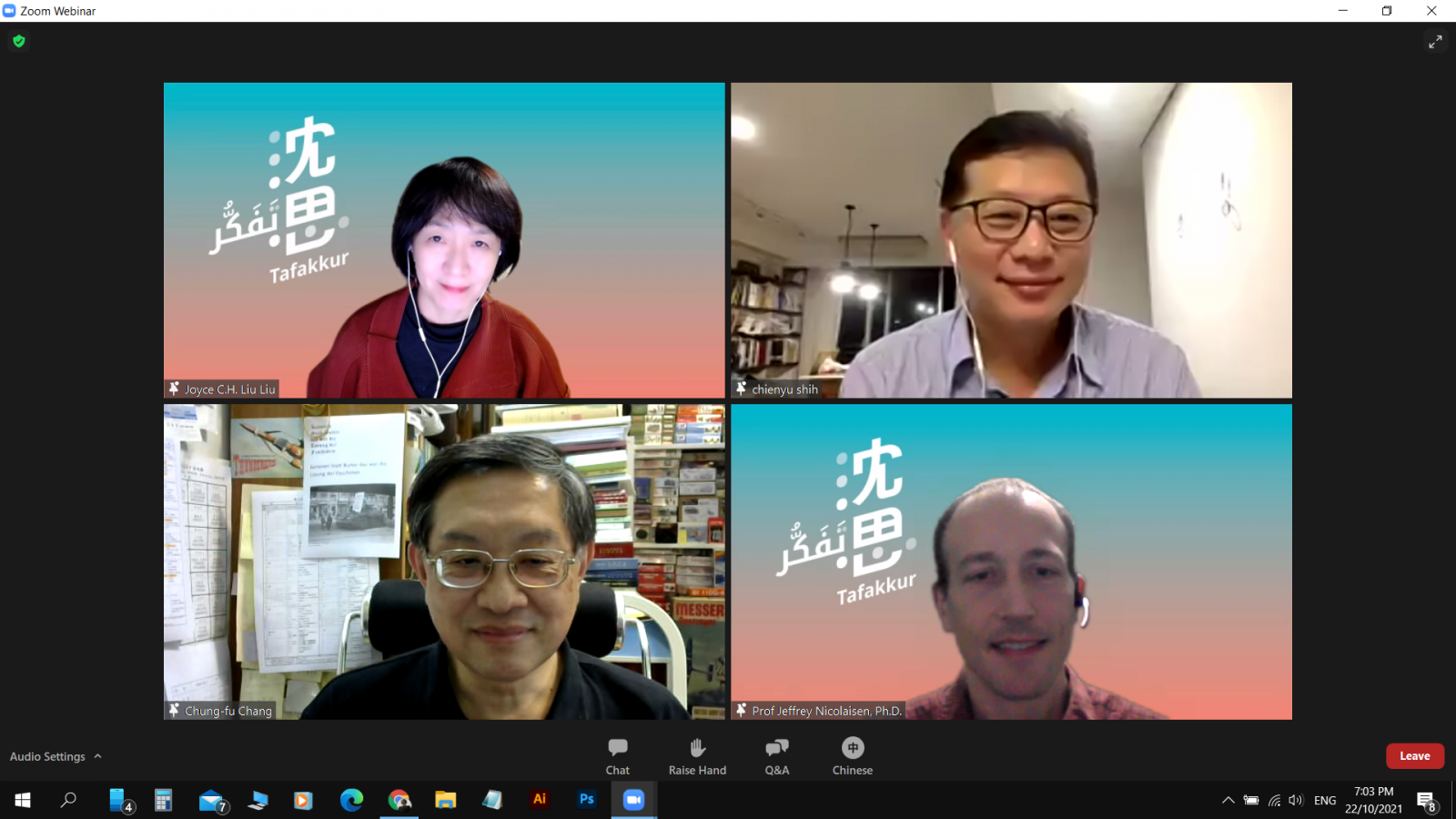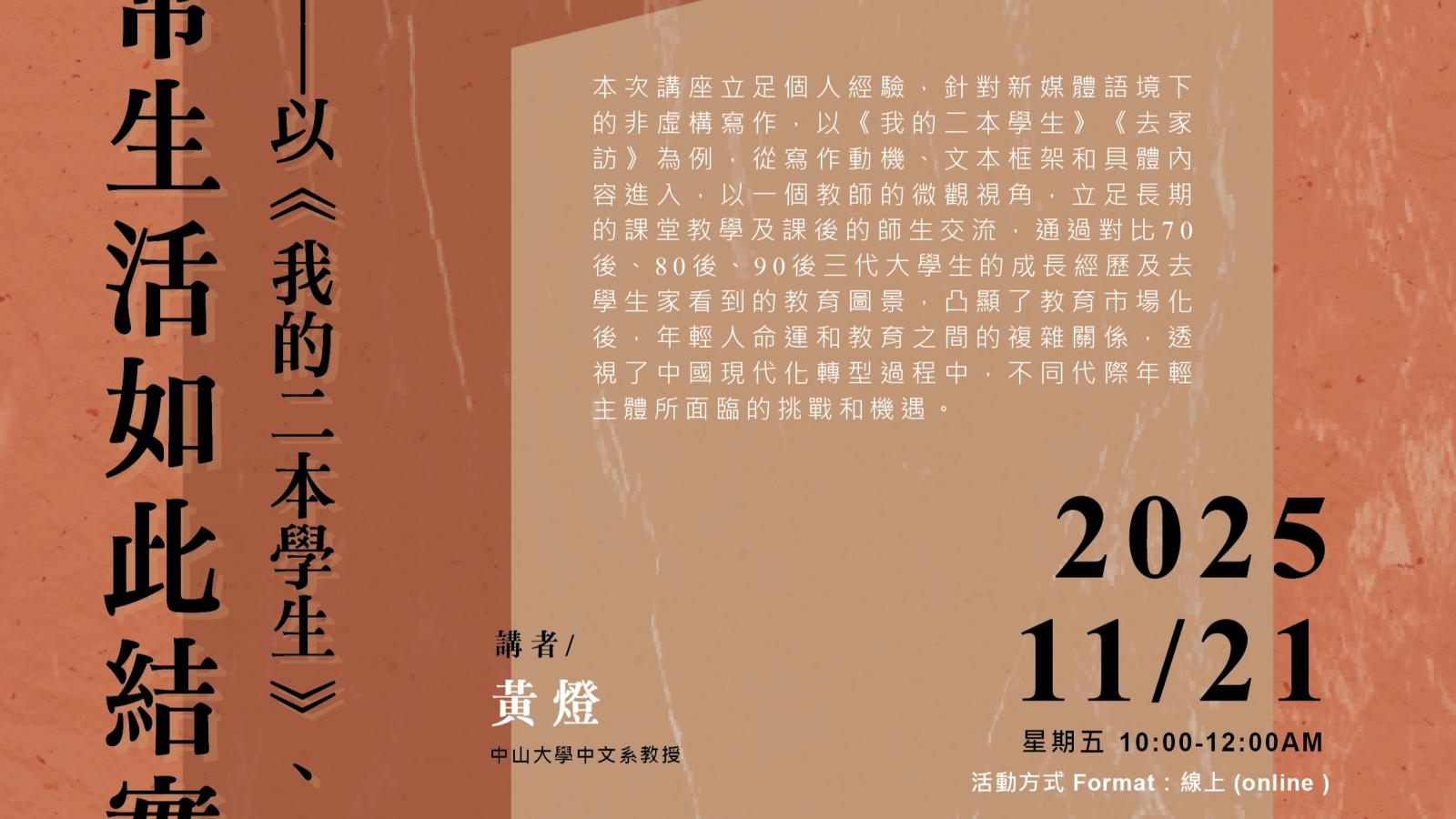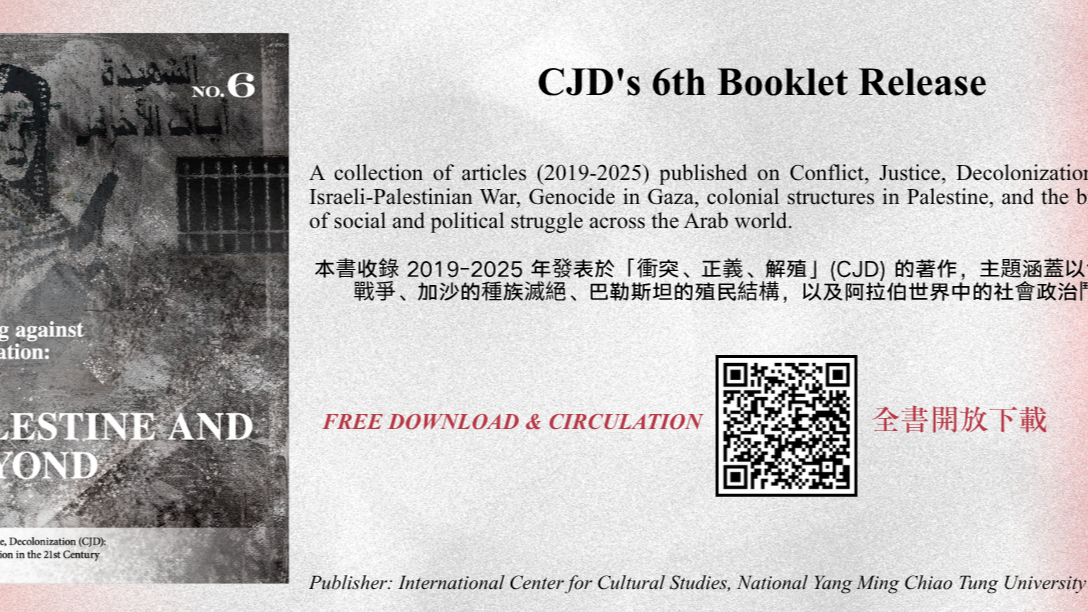

Activity Report: The Tafakkur ICCS-NYCU Muslim Film Festival Day 1
2022-02-09
The Tafakkur ICCS-NYCU Muslim Film Festival Day 1-REPORT
Date: 2021/10/22
Venue: Zoom webinar
Text / Irfan Muhammad (M.A. Student at IACS-UST at NYCU)
The first lecture of the Tafakkur ICCS-NYCU Muslim Film Festival 2021 was opened by professor Syed Farid Alatas from the Department of Sociology and Malay Studies, National University of Singapore. On the topic of "Approaches to the Understanding of Islam: Doctrine, Culture, Ideology, and Utopia", Prof. Farid said, like any other religion, we must view Islam from its universal teachings and compare it with human-made interpretations that reflect the witnesses, feelings, and cultural biases of human-being.
Islam is a big religion that has many pure, pristine, universal values. However, there are many negative portrayals of Muslims on misogyny, violence, or terrorist acts. This goes to show that while humans are able to resonate with universal ideas that are good for humanity; at the same time, they will also interpret these teachings based on their feelings, cultural biases, and even the innate human capacity to be evil.
We must understand what we mean by Islam and understand Islam from many different levels like any other religion. For Muslims, Islam should be how it is intended by God, but once that religion is revealed to, read, and interpreted by human beings, different opinions about the doctrine will arise.
We then come to the discussion on the culture of Muslims where their material and idea culture may or may not be influenced by Islam. Nevertheless, this culture will always reflect upon Islam. There are three ways to understand the relationship between Muslim culture and Islam, and the first is where culture is directly influenced by Islam. One example brought up by Prof. Farid is the culture of breaking fast with dates. Practised by the Prophet Muhammad PBUH, breaking fast with dates has become a traditional culture directly influenced by Islam that is practised by Muslims everywhere. Similar examples are abundant, and while some of these practices influence a Muslim’s entire life, there are also small things that are taken for granted by the Muslim community, such as the habit of eating with their right hand and eating with three fingers which are considered good manners for a Muslim.
Secondly, there is the way of life of a Muslim that can be against or contrary to the teachings of Islam. Islam never prohibited women from receiving an education. Islam also gave women property rights that cannot be claimed by anyone including her husband. Yet in some Islamic societies, women are not only prohibited from learning but also being stripped of their rights over their property. For the third way, Islam is neutral and has nothing to say over one’s way of life. Taking halal food as an example, Islam regulates halal food for Muslims, but not specifically on certain foods. It goes back to the tradition of the community whether to eat bread or rice.
According to Prof. Farid, all these can be associated with Islam, but when it comes to the assessments of Muslims, we have to be clear about what we want to talk about. Are we talking about the Quran, the practices in Islam, the religious doctrines that are diverse and based on interpretation of human beings, or are we talking about schools of philosophy, the Sufism order, or Muslims in general?
In the views of some Muslims, especially Muslim elites, Islam is more than just a religion or revelation. Instead, it reinforces their position in society or social situations. For that reason, these views can be classified as ideology and utopia.
Take the example of people who believe in Islamic economics. They claim that Islamic economics is based on Islamic teachings and a good economic system. However, what they call Islamic economics reflects capitalist interests where"the proponent claims it is purely Islam, but we can say this is the pro-capitalist stance," said Prof. Farid.
On the other hand, we can also find Muslims fighting against capitalism through a political-economic stance that is more socialist. In Indonesia, for example, about 100 years ago, there is Haji Oemar Said Tjokroaminto who wrote about Islam and socialism against capitalist oppression by the Dutch colonial.
"So they had utopian ideas in the sense that the ideas were not meant to conserve or to preserve the system, but rather to overthrow the system," said Prof. Farid.
The basic takeaway is that Islam needs to be understood from many levels. We must first clarify what does Islam mean. Are we referring to the universal Islam, its doctrine, theories, ideologies, utopians, or people culture? Secondly, Islam is heterogeneous. There are very vast differences among Muslims in terms of the practices, culture, and designs influenced not only by the revelation of Islam but by many other social, geographical and historical factors.
Also speaking at MMF-NYCU 2021 is Okky Puspa Madasari, an Indonesian novelist, essayist, and academic. On the topic of “Imagining Islam: The Battle of Identity and Ideology in Film”, Okky screened some movies at the forum to introduce the Indonesian landscape of Islamic films.
According to Okky, Islam has been portrayed in different imaginations along with history. How filmmakers have been imagining Islam cannot be separated from the conditions, situations and events within their society. The films are a battleground of ideologies, and through the background of its filmmakers and its audiences, we can see what kind of Islam is presented in it.
Okky then made a comparison between the film "Tjut Nja’ Dhien" released in 1998 and "Ayat-ayat Cinta '' which was released in the mid-2000s. While "Tjut Nya’ Dhien" from 1998 features Muslim women with strong character who are against colonialism, “Ayat-ayat Cinta” that was made after 1998 was about a woman busy getting attention from a man, who at the end of the day allow her husband to do polygamy because she believes it is a noble thing to do in her religion.
To understand that, we also have to make clear the status and condition of Indonesia before 1998 and after 1998. Before 1998, there was repression against Islam. As a result, the Islamic lifestyle and Islamic pop culture were marginalized. On the contrary, after 1998, Muslims gained their freedom in politics and daily life, and so Islamic lifestyle and pop culture gained dominance. The girl in the hijab, for example, is characterized as good and moral in the film, while those who are not wearing it are bad.
When the film is a battlefield of identity and ideology, not only does the film function to represent a Muslim group or reach Muslim audiences, it also functions as an indoctrination tool to promote certain Islamic teachings and ways of life, or on the other hand as political power.
The battle, Okky said, happens inside and outside the film. On the inside, debates surround the story, leading roles, the costumes, and even the religious faiths of the casts and filmmakers. After the film is released, the battle continues with public reception and censorship, sometimes coming from Muslim actors, authorities, or leaders who don't agree with the Islamic perception of the film. As the comments from Muslim leaders carries influence, the narrative of the film is not as free as we thought.
There are three kinds of responses or stances taken by the filmmakers. Some of them will do self-censoring, some of them will choose to negotiate, and some of them, for the sake of freedom of expression, will choose to resist these doctrines. However, for those who choose to resist, it is not infrequent to face a screening ban from those who do not agree with their ideologies, and some of them are even being attacked or jailed.
Film Screening
Two films from Indonesia were screened on the first day of the Muslim Film Festival. The first film, “Atas Nama Percaya” (In the Name of Belief), directed in 2019 by Ari Trismana, is a collaborative work between the Center for Religious and Cross-cultural Studies (CRCS) UGM, WatchdoC Documentary, and the Pardee School of Global Studies, Boston University, with support from the Henry Luce Foundation.
This 36-minute film documents the lives of penghayat (believers) of ancestral beliefs or folk religions in West Java and East Nusa Tenggara. They have experienced a long history of discrimination, ranging from being forced to identify themselves with one of six state-recognized religions, to being accused of being atheists and communists.
It was only after 2017 when the Constitutional Court allowed them to list their indigenous religions on their identity cards had there was significant progress in recognizing equal rights for this community of believers. However, some challenges remain. The Aliran Kebatinan Perjalanan community in West Java and the Marapu community in East Nusa Tenggara tells the story in this film.
The second film screened was entitled “?”. Directed in 2011 by a famous Indonesian director, Hanung Bramantyo, this film portrays Indonesia's religious pluralism.
Religious diversity in Indonesia often results in misconceptions among each other, which leads to conflict. This situation is represented in this film through the interactions of three families with different religions: Buddhism, Islam, Catholicism.
The religious life in Indonesia is fully portrayed in this film as well from the Christians’ wrong assumption of Islam to some Muslims who are racist toward ethnic Chinese. Yet, on the contrary, there are also moderate Muslims who dare to defend people of other religions and are against extreme Islamic ideas.
*****
The second session of the first day features the Uyghur crisis that in recent years has come under the spotlight. Uyghurs, a Muslim-majority ethnic group inhabiting the Xinjiang region under the control of the PRC (People’s Republic of China) authorities, are part of a vulnerable group that often faces repression.
Under this theme, the festival screened a film entitled "On the Tightrope". Released in 2007, this documentary by Petr Lom follows the stories of Uyghur children living in an orphanage in China's Xinjiang province. Although the repression of the Uyghur ethnic group by the PRC government has been widely reported, Lom tries to describe their lives differently. Instead of describing how the repression was carried out, he conducted interviews with children who dream of becoming tightrope walkers, which is an Uyghur ancestral tradition.
Through tightrope walking, Lom seems to want to show how Uyghurs balance their lives as Muslims living under the communist regime. On one hand, they are restricted in their religious practices; on the other hand, they continue to be indoctrinated to become Chinese and eventually become communists.
Following the screening is a panel discussion between Prof. Chien-Yu Shih, the associate Research Fellow at the Institute for National Defense and Security Research and Prof. Chang Chung Fu from the Department of Ethnology, National Chengchi University. One of the rationales behind the PRC’s repression of ethnic Xinjiang, said Prof. Shih, was the attempt of Sinicization through state control over religion. To have control over religion, PRC requires the religion to improvise along with Chinese culture and ethics. Prof. Shih then quoted Prof. Fenggang Yang, a sociologist from Purdue University, on his theory of the triple "religious market".
For control purposes, the religion is divided into three groups by PRC authorities. The first group is referred to as the red market. There are five religions officially recognized by the PRC government: Taoism, Buddhism, Islam, Catholicism and Protestantism. The second group is the grey market, namely religions that are unrecognized and legally undefined religions, including folk religion and others. The third one is the black market. This group is identified as an illegal religion, or in PRC government terms, referred to as an evil cult.
Xi Jinping, the president of PRC, attempts to make all religions red and erase the grey and black. This was later strengthened by the 2017 Regulation on Religious Affairs. The policy that began in 2016 through the National Conference on Religious Relations mandated four restraints. Among other things, religion should implement core socialist values that preach socialism and the ideology of the Chinese Communist Party (CCP). Following the vague definition of "religious extremism", the policy also threatens its propagators, supporters, and funders with severe punishment as being part of an "evil cult". This rule very possibly points toward Islamism.
What is happening in Xinjiang right now is very messy. Not only is the PRC trying to securitize Islamic beliefs, but there is also an extreme movement circulating a 9/11 narrative that links the influence of Al-Qaeda to the East Turkestan Islamic Movement, which is a political faction in Xinjiang.
To solve this, the PRC government takes preemptive measures on the offensive by attacking in anticipation of immediate aggression and danger. First, they legitimize PRC's needs in counterterrorism or deradicalization programs. They then restructure the Xinjiang society in line with the Chinese Han majority through preventive oppression to maintain the status quo. This is done by erasing the cultural character of the local community by assimilation if not genocide. These two methods were also used interchangeably to allow for more elasticity in future policy adjustment.
The religious persecution of Muslims in Xinjiang presses on with the demolition of illegal religious architects including buildings, religious symbols, signs, Arabic script, or graveyards and shrines. There is also a strict prohibition on Islamic practices in everyday life such as the wearing of hijab for women and the growing of beards for men. The PRC government has also dissolved Islamic worship and arrested religious leaders. They then regulate mosque furnishings by placing portraits and slogans of Xi Jinping or Mao Zedong and raising the PRC national flag at the main gate to show patriotism.
According to Prof. Shih, the Chinese government continues to highlight that the globalization of Islamism or terrorism has jeopardized the practice of Islam in Xinjiang among Uyghurs and other Turkic minorities. Uyghur Muslims, based on his contact, can also be categorized into three: those who practice it culturally, those who practice Islam selectively for non-political purposes, and those who practice politics. The third type can be divided into many more groups from politicians to Islamist Jihadists, yet the majority of the Uyghur Muslims belong to the first category.
Prof. Chang, the second speaker, shares a similar view to Prof. Shih. In his presentation entitled "The Paradoxical Jihad of 'Sinicization': New Coming Campaign of Muslim Assimilation Under the Spreading Islamophobic Sentiment in Contemporary China", he explained that Islam is not new in China and has been embraced by some Chinese people for a very long time.
However, there are two kinds of Muslims in China. The Hui Minzu is known as Sinophone Muslims or Sino Muslims, meaning that they are Chinese-speaking Muslims, and on the other hand, we have the Uyghurs who are known as Turkic-Speaking Muslims. The distribution of Sinophone Muslims is dominant as the symbiotic structure between the Muslim minority and the Han majority under the modern Chinese nation-state has been going on for more than 1000 years occurring in three dimensions: cultural change, social adaptation, and ethnic identity.
Therefore it comes as no surprise that many provinces in China such as Yunnan and Linxia have quite a lot of followers of Islam. In contrast to the situation in Xinjiang however, religious expression in the Sinophone Muslim region is relatively supported by the state. In Yunnan for example, there is a great combination of Confucianism and Islamic thought. Some old teachings like Qadim and Sufism Orders (Tarekat) also present Chineseness elements in the northwestern region of China. It is clearly visible, through the architecture of their mosque, that instead of having an Arabic style, some mosque architectures have a Chinese style. In tarekat orders, such as the Jahriyya in Linxia, respect and commemoration for their leaders of the order (murshid) are through the burning incense sticks.
The question begs to be asked: How is it that in recent years, themes like "Islamophobia in China" started to emerge?
The anti-Islam sentiment in China cannot be equated with Islamophobia in the West. In western countries, a fear of Islam exists because of their perception toward immigrants. Meanwhile, in China, Islam is not a new religion. It has existed for thousands of years. The new trend emerged after 2012 when the Chinese Communist Party waged a new war of Muslim assimilation under the spread of Islamophobic sentiments through an ambiguous excuse: total Sinicization of all religions. Following the government propaganda, in the new media, especially on the internet, extreme left intellectuals from the Han majority started openly spreading anti-Muslim hostility through hate speech.
The target of the CCP in this policy is very clear. They all point to the idea of jihad, scriptural Wahhabism on Sinophone Muslims and heterogeneous Turkic-speaking Muslims in Xinjiang. However, how can we distinguish these targets from those who are traditional and have been localized?
In 2015, the government also explicitly abolished three tendencies that they feared would make Islam in China extreme. The three tendencies are Arabicization, Saudicization which refers to Wahhabism, and Pan-Islamization which refers to political factions such as the Ikhwan. As a result, the government-mandated the change of Arabic symbols in the mosque. The dome, for example, is no longer visible in some mosques in China and has been replaced with the Confucian style of temples used by the Han majority.
Prof. Chang said the Xinjiang crisis and the proliferation of extreme anti-Muslim beliefs in China would pose three menaces, namely ethnic separatism, international terrorism, and religious extremism. However, he believes that the majority of Muslims in China are Muslims who believe in Islamic moderation. The centuries-old symbiosis between the Han majority and the Muslim minority can only be ensured and sustained through embracing moderate Islam as a part of Chinese civilization and allowing ethnic Muslims to preserve their socio-cultural identity in China.



近期新聞 Recent News

Report|Conceptualizing Digital Governance in the Age of Semiconductors: A Critical Review of Keywords and Concepts
2025-12-03
more

New Publication | Writing against Occupation: Palestine and Beyond (CJD Booklet No.6)
2025-11-12
more